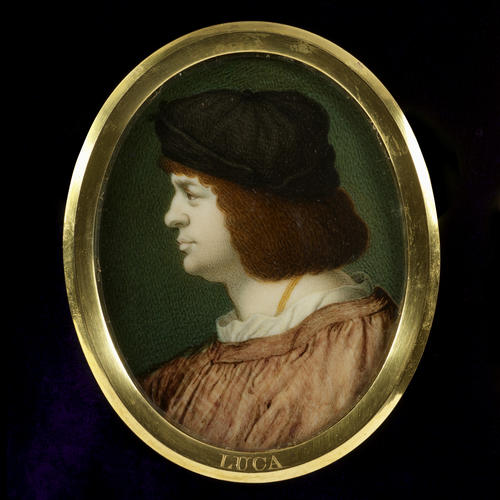Giuseppe Macpherson (1726-c. 1780)
Luca di Leida (1489/94-1533) c.1772-80
Watercolour in ivory | 7.1 x 5.5 cm (sight) (sight) | RCIN 421133
-
Luca di Leida, or van Leyden was one of the most important engravers of the Renaissance as well as being a painter, designer of woodcuts and glass painter. He lived in Leiden all his life, trained initially with his father, Hugo Jacobsz, then entered the workshop of Cornelius Engebrechtszoon. Luca demonstrated great skill in engraving from a very young age – the earliest dated print by him, Mohammed and the Monk Sergius (1508, New York, Metropolitan Museum of Art), was probably made when he was still a teenager. He met Albrecht Dürer in Antwerp around 1521, when Dürer painted his portrait (Lille, Musée des Beaux Arts) and Dürer was the greatest influence on his work. Many of his engravings were genre scenes (images of ordinary life) with a moral message, such as the Chess Players (c.1510, Berlin, Gemäldegalerie), and the triptych with the Worship of the Golden Calf (c.1525, Amsterdam, Rijksmuseum). His biographer, Karel van Mander, suggests he was a pleasure-loving dilettante, but he left a large output of work and Giorgio Vasari, the artist and biographer, regarded his work in some respects as superior to Dürer.
This miniature is one of the collection of copies of 224 self-portraits by artists in the Uffizi Palace, Florence, that Lord Cowper, the art collector and patron, commissioned Giuseppe Macpherson (1726-1780) to paint. He presented the miniatures to King George III in two batches, in 1773 and 1786. Macpherson followed the original self-portraits quite closely, but copied only the head and shoulders. He inscribed the artists' names on the backs of the miniatures – several differ from those in the modern Uffizi catalogue, notably: Bazzi, Bellini, Campi, Annibale Carracci, Gabbiani, Masaccio, Metsys, Moroni, Pencz, Licinio, Schiavone and Spada. None of the miniatures is signed, apart from Macpherson's own self-portrait, which is inscribed: Giuseppe Macpherson / Autore della serie (Giuseppe Macpherson / Author of the series).Macpherson was born in Florence, the son of Donald Macpherson, a footman in the service of Alexander, 2nd Duke of Gordon. He was a pupil of Pompeo Batoni and painted miniatures and enamel portraits in Italy, France and Germany, finally settling in Florence. A James Macpherson is recorded in London and Paris in 1754 but it is not certain that this is the same person. He was described in 1776 as having a special talent for painting on enamel and as being 'almost the only painter in Europe who possesses this art to perfection'. He had a distinguished client list which included some of the crowned heads and dignitaries of Europe. In 1778, he was invited to add his own self-portrait to the famous painters in the grand duke's collection as it 'would do honour to Florence to enrich the collection with a work which shows that we still have some men of true merit' according to Giuseppe Pelli, director of the Uffizi at the time.
Provenance
Presented to George III by Lord Cowper
-
Creator(s)
Acquirer(s)
-
Medium and techniques
Watercolour in ivory
Measurements
7.1 x 5.5 cm (sight) (sight)
Other number(s)
RL 01.7/14










